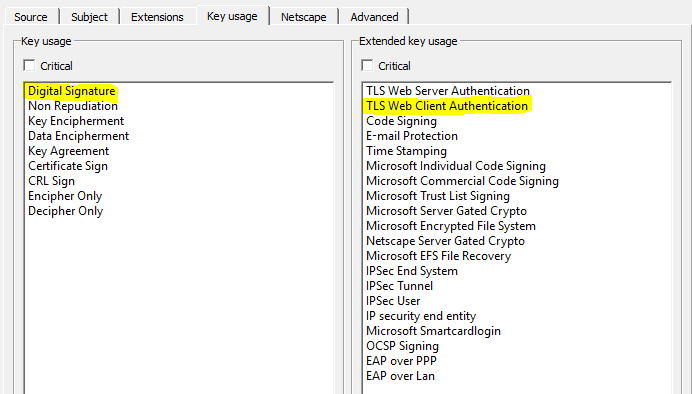To secure SIP traffic by TLS, you need a certificate for each hop. There is no end-to-end security. If all SIP clients connect to a local Asterisk server that uses the SIP proxy to traverse the firewall, you must create certificates for the following:
- SIP client
- Asterisk server
- SIP Proxy service on the Barracuda CloudGen Firewall
Before You Begin
Create and export a root certificate in PEM format. For instructions, see How to Create Certificates with XCA.
Create a Client Certificate
Step 1. Create the Client Certificate
To create the client certificate:
- In XCA, click the Certificate signing requests tab and then click New Request. The Create Certificate Signing Request window opens.
- Configure the identifying information.
- Click the Subject tab.
- Configure the settings in the Distinguished name section.
- In the New Key window, enter a name for the certificate, select a key size, then click Create.
- Configure the X.509 extensions.
- Click the Key usage tab.
- From the Key usage pane, select Digital Signature.
- From the Extended key usage pane, select TLS Web Client Authentication.
- Click OK to create the certificate. It then appears under the Certificate signing requests tab with a Signed status of Unhandled.
Step 2. Sign the Client Certificate
To sign the client certificate:
- Click the Certificate signing requests tab.
- Right-click the client certificate and then click Sign. The Create Certificate Signing Request window opens.
- In the Signing section under the Source tab, select Use this Certificate for signing and then select the root certificate from the drop-down menu.
- Click OK to sign the certificate. It then appears under the Certificate signing requests tab with with the status of Signed.
Step 3. Export the Client Certificate
To export the client certificate:
- Click the Certificates tab.
- Select the client certificate and then click Export.
- In the Certifikate Export window, select PEM Cert + key from the Export Format list and then click OK.
Create an Asterisk Server Certificate
If an Asterisk server is used to connect to the SIP proxy, create a certificate for the Asterisk server.
Step 1. Create a Certificate
To create a certificate for the Asterisk server:
- Click the Certificate signing requests tab and then click New Request.
- Configure the identifying information.
- Click the Subject tab.
- Configure the settings in the Distinguished name section.
- In the commonName field, enter the IP address of the SIP proxy (e.g.,
10.0.10.8). - In the New Key window, enter a name for the certificate, select a key size, and then click Create.
- Configure the X.509 extensions.
- Click the Key usage tab.
- From the Key usage pane, select Digital Signature and Key Encipherment.
- From the Extended key usage pane, select TLS Web Client Authentication and TLS Web Server Authentication.
- Click OK to create the certificate. It then appears under the Certificate signing requests tab with a Signed status of Unhandled.
Step 2. Sign the Certificate
To sign the certificate:
- Click the Certificate signing requests tab.
- Right-click the client certificate and then click Sign. The Create x509 Certificate window opens.
- In the Signing section under the Source tab, select Use this Certificate for signing and then select the root certificate from the drop-down menu.
- Click OK to sign the certificate. It then appears under the Certificate signing requests tab with with the status of Signed.
Step 3. Export the Certificate
To export the certificate:
- Click the Certificates tab.
- Select the client certificate and then click Export.
- In the Certifikate Export window, select PEM Cert + key from the Export Format list and then click OK.
Create a SIP Proxy Certificate
Step 1. Create the Certificate
To create the certificate:
- Click the Certificate signing requests tab and then click New Request.
- Configure the identifying information.
- Click the Subject tab.
- Configure the settings in the Distinguished name section.
- In the New Key window, enter a name for the certificate, select a key size, and then click Create.
- Configure the X.509 extensions.
- Click the Key usage tab.
- From the Key usage pane, select Digital Signature and Key Encipherment.
- From the Extended key usage pane, select TLS Web Client Authentication and TLS Web Server Authentication.
- Click OK to create the certificate.
Step 2. Sign the Certificate
To sign the certificate:
- Click the Certificate signing requests tab.
- Right-click the client certificate and then click Sign. The Create x509 Certificate window opens.
- In the Signing section under the Source tab, select Use this Certificate for signing and then select the root certificate from the drop-down menu.
- Click OK to sign the certificate. It then appears under the Certificate signing requests tab with with the status of Signed.
Step 3. Export the Certificate
To export the certificate:
- Click the Certificates tab.
- Select the client certificate and then click Export.
- In the Certifikate Export window, select PEM Cert + key from the Export Format list and then click OK.



